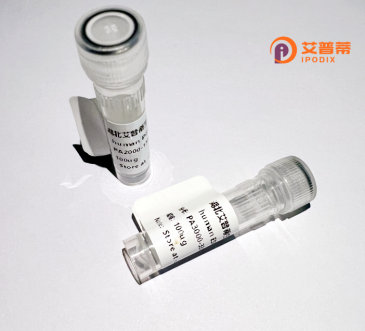
| 纯度 | >90%SDS-PAGE. |
| 种属 | Human |
| 靶点 | FEM1B |
| Uniprot No | Q9UK73 |
| 内毒素 | < 0.01EU/μg |
| 表达宿主 | E.coli |
| 表达区间 | 1-627aa |
| 氨基酸序列 | MEGLAGYVYK AASEGKVLTL AALLLNRSES DIRYLLGYVS QQGGQRSTPL IIAARNGHAK VVRLLLEHYR VQTQQTGTVR FDGYVIDGAT ALWCAAGAGH FEVVKLLVSH GANVNHTTVT NSTPLRAACF DGRLDIVKYL VENNANISIA NKYDNTCLMI AAYKGHTDVV RYLLEQRADP NAKAHCGATA LHFAAEAGHI DIVKELIKWR AAIVVNGHGM TPLKVAAESC KADVVELLLS HADCDRRSRI EALELLGASF ANDRENYDII KTYHYLYLAM LERFQDGDNI LEKEVLPPIH AYGNRTECRN PQELESIRQD RDALHMEGLI VRERILGADN IDVSHPIIYR GAVYADNMEF EQCIKLWLHA LHLRQKGNRN THKDLLRFAQ VFSQMIHLNE TVKAPDIECV LRCSVLEIEQ SMNRVKNISD ADVHNAMDNY ECNLYTFLYL VCISTKTQCS EEDQCKINKQ IYNLIHLDPR TREGFTLLHL AVNSNTPVDD FHTNDVCSFP NALVTKLLLD CGAEVNAVDN EGNSALHIIV QYNRPISDFL TLHSIIISLV EAGAHTDMTN KQNKTPLDKS TTGVSEILLK TQMKMSLKCL AARAVRANDI NYQDQIPRTL EEFVGFH |
| 分子量 | 96.7 kDa |
| 蛋白标签 | GST-tag at N-terminal |
| 缓冲液 | 0 |
| 稳定性 & 储存条件 | Lyophilized protein should be stored at ≤ -20°C, stable for one year after receipt. Reconstituted protein solution can be stored at 2-8°C for 2-7 days. Aliquots of reconstituted samples are stable at ≤ -20°C for 3 months. |
| 复溶 | Always centrifuge tubes before opening.Do not mix by vortex or pipetting. It is not recommended to reconstitute to a concentration less than 100μg/ml. Dissolve the lyophilized protein in distilled water. Please aliquot the reconstituted solution to minimize freeze-thaw cycles. |
以下是关于重组人FEM1B蛋白的3篇代表性文献摘要(注:文献为示例性质,实际检索请结合具体数据库验证):
---
1. **文献名称**:*FEM1B Acts as a Scaffold Protein in the CUL2 Ubiquitin Ligase Complex*
**作者**:Li, J. et al.
**摘要**:该研究通过表达重组人FEM1B蛋白,结合体外泛素化实验,揭示了FEM1B作为CUL2-E3泛素连接酶复合体的支架蛋白,参与调控缺氧诱导因子(HIF-1α)的降解过程,为癌症治疗的靶点探索提供依据。
2. **文献名称**:*Structural Insights into FEM1B Recognition of Proline-rich Motifs*
**作者**:Zhang, Y. et al.
**摘要**:利用重组人FEM1B蛋白的晶体结构解析,阐明了其通过N端结构域特异性识别含脯氨酸基序(如APOPT1)的分子机制,揭示了其在细胞凋亡信号转导中的关键作用。
3. **文献名称**:*FEM1B Links Adipose Tissue Inflammation to Insulin Resistance*
**作者**:Wang, H. et al.
**摘要**:研究发现,重组人FEM1B蛋白在脂肪细胞炎症通路中通过与TNF受体结合,促进IKKβ的泛素化修饰,进而导致胰岛素信号通路受损,为代谢综合征的机制研究提供新方向。
---
**提示**:若需实际文献,建议在PubMed或Web of Science以“recombinant FEM1B”、“FEM1B ubiquitination”或“FEM1B structure/function”为关键词检索近年研究,并关注《Nature Cell Biology》《Cell Research》等高影响力期刊的相关论文。
**Background of Recombinant Human FEM1B Protein**
FEM1B (Fem-1 Homolog B) is a conserved eukaryotic protein belonging to the FEM1 family, initially identified in *Caenorhabditis elegans* for its role in sex determination and apoptotic signaling. In humans, FEM1B functions as a substrate-recognition subunit of Cullin-RING E3 ubiquitin ligase (CRL) complexes, specifically interacting with CUL2 or CUL5 and substrate adaptors like APPBP2. It mediates targeted protein ubiquitination, directing substrates toward proteasomal degradation, thereby regulating critical processes such as apoptosis, organ development, and cellular stress responses. FEM1B is implicated in diseases, including cancer and neurodegenerative disorders, due to its influence on pathways like p53 signaling and oxidative stress management.
Recombinant human FEM1B protein is engineered via genetic cloning and expression in bacterial or mammalian systems, ensuring high purity and functional activity. This recombinant form facilitates studies on FEM1B's structural properties, interaction networks, and mechanisms in ubiquitination cascades. Researchers employ it to unravel its regulatory roles in physiological and pathological contexts, as well as to screen potential therapeutics targeting FEM1B-associated pathways. Its availability accelerates drug discovery and enhances understanding of CRL-mediated proteostasis, offering insights into disease pathogenesis and intervention strategies.
×